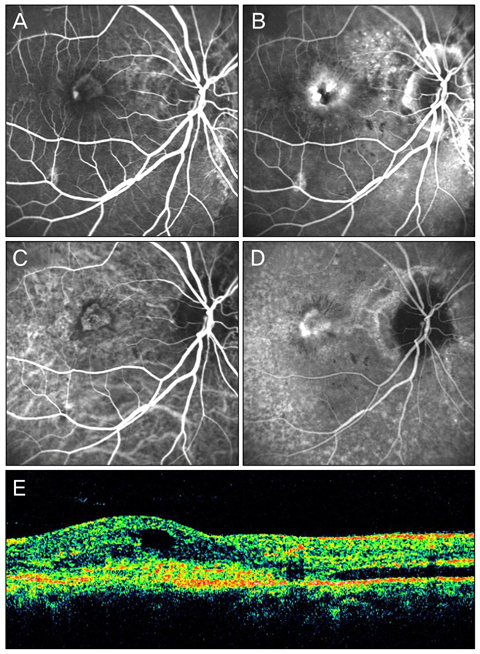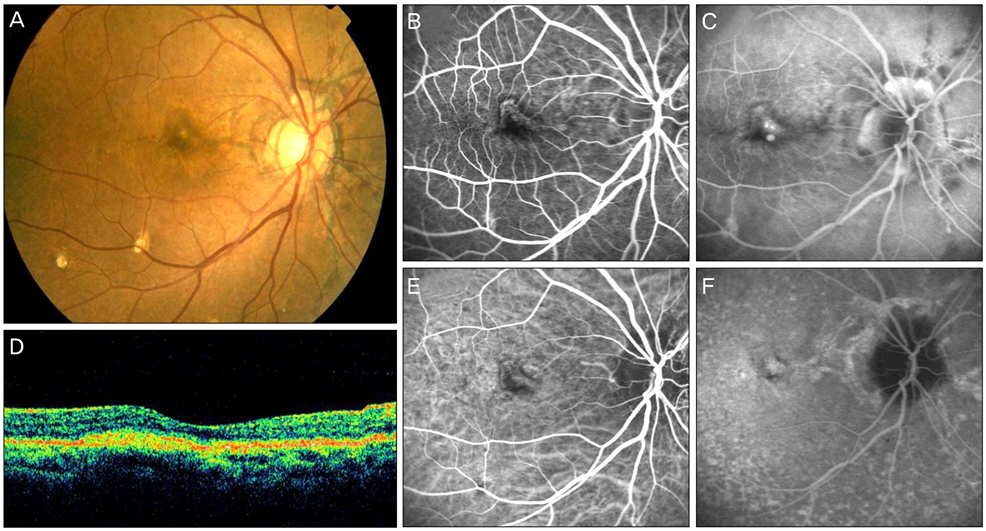Korean J Ophthalmol.
2011 Jun;25(3):218-221. 10.3341/kjo.2011.25.3.218.
A Case of Intravitreal Bevacizumab Injection for the Treatment of Choroidal Neovascularization in Angioid Streaks
- Affiliations
-
- 1Department of Ophthalmology, Pusan National University School of Medicine, Busan, Korea.
- 2Department of Ophthalmology, Kyungpook National University School of Medicine, Daegu, Korea. kimsy@knu.ac.kr
- KMID: 1010033
- DOI: http://doi.org/10.3341/kjo.2011.25.3.218
Abstract
- A 56-year-old Korean woman presented with decreased visual acuity of the right eye. She had a history of two photodynamic therapy treatments for choroidal neovascularization (CNV) due to angioid streaks in her left eye with central scarring and low visual acuity. She was diagnosed with subfoveal CNV due to angioid streaks in her right eye and treated with six intravitreal bevacizumab (1.25 mg / 0.05 mL) injections over one year. Best corrected visual acuity improved from 20 / 125 at baseline to 20 / 50 at the final visit. The area of CNV had changed into a fibrotic scar by the final visit, and fluorescein angiography and indocyanine green angiography revealed no evidence of leakage. Optical coherence tomography showed that central macular thickness decreased from 311 microm at baseline to 203 microm with complete resolution of subretinal and intraretinal fluid at the final visit. Intravitreal bevacizumab for CNV associated with angioid streaks prevented the progression of disease and resulted in the improvement of visual acuity after one year of follow-up in our patient.
MeSH Terms
-
Angiogenesis Inhibitors/*administration & dosage
Angioid Streaks/*complications
Antibodies, Monoclonal/*administration & dosage
Choroidal Neovascularization/*drug therapy/*etiology/physiopathology
Female
Follow-Up Studies
Humans
Intravitreal Injections
Macula Lutea/drug effects/pathology
Middle Aged
Tomography, Optical Coherence
Visual Acuity/drug effects
Figure
Reference
-
1. Mansour AM. Systemic associations of angioid streaks. Int Ophthalmol Clin. 1991. 31:61–68.2. Piro PA, Scheraga D, Fine SL. Fine SL, Owens SL, editors. Angioid streaks: natural history and visual progression. Management of retina vascular and macular disorders. 1983. Baltimore: Williams & Wilkins;136–139.3. Mansour AM, Shields JA, Annesley WH Jr, et al. Macular degeneration in angioid streaks. Ophthalmologica. 1988. 197:36–41.4. Singerman LJ, Hatem G. Laser treatment of choroidal neovascular membranes in angioid streaks. Retina. 1981. 1:75–83.5. Pece A, Avanza P, Galli L, Brancato R. Laser photocoagulation of choroidal neovascularization in angioid streaks. Retina. 1997. 17:12–16.6. Lim JI, Bressler NM, Marsh MJ, Bressler SB. Laser treatment of choroidal neovascularization in patients with angioid streaks. Am J Ophthalmol. 1993. 116:414–423.7. Karacorlu M, Karacorlu S, Ozdemir H, Mat C. Photodynamic therapy with verteporfin for choroidal neovascularization in patients with angioid streaks. Am J Ophthalmol. 2002. 134:360–366.8. Menchini U, Virgili G, Introini U, et al. Outcome of choroidal neovascularization in angioid streaks after photodynamic therapy. Retina. 2004. 24:763–771.9. Mennel S, Schmidt JC, Meyer CH. Therapeutic strategies in choroidal neovascularizations secondary to angioid streaks. Am J Ophthalmol. 2003. 136:580–582.10. Shaikh S, Ruby AJ, Williams GA. Photodynamic therapy using verteporfin for choroidal neovascularization in angioid streaks. Am J Ophthalmol. 2003. 135:1–6.11. Heimann H, Gelisken F, Wachtlin J, et al. Photodynamic therapy with verteporfin for choroidal neovascularization associated with angioid streaks. Graefes Arch Clin Exp Ophthalmol. 2005. 243:1115–1123.12. Arias L, Pujol O, Rubio M, Caminal J. Long-term results of photodynamic therapy for the treatment of choroidal neovascularization secondary to angioid streaks. Graefes Arch Clin Exp Ophthalmol. 2006. 244:753–757.13. Rosenfeld PJ, Moshfeghi AA, Puliafito CA. Optical coherence tomography findings after an intravitreal injection of bevacizumab (avastin) for neovascular age-related macular degeneration. Ophthalmic Surg Lasers Imaging. 2005. 36:331–335.14. Yamamoto I, Rogers AH, Reichel E, et al. Intravitreal bevacizumab (Avastin) as treatment for subfoveal choroidal neovascularisation secondary to pathological myopia. Br J Ophthalmol. 2007. 91:157–160.15. Bhatnagar P, Freund KB, Spaide RF, et al. Intravitreal bevacizumab for the management of choroidal neovascularization in pseudoxanthoma elasticum. Retina. 2007. 27:897–902.16. Rinaldi M, Dell'Omo R, Romano MR, et al. Intravitreal bevacizumab for choroidal neovascularization secondary to angioid streaks. Arch Ophthalmol. 2007. 125:1422–1423.17. Wiegand TW, Rogers AH, McCabe F, et al. Intravitreal bevacizumab (Avastin) treatment of choroidal neovascularisation in patients with angioid streaks. Br J Ophthalmol. 2009. 93:47–51.18. Neri P, Salvolini S, Mariotti C, et al. Long-term control of choroidal neovascularisation secondary to angioid streaks treated with intravitreal bevacizumab (Avastin). Br J Ophthalmol. 2009. 93:155–158.19. Gomi F, Nishida K, Oshima Y, et al. Intravitreal bevacizumab for idiopathic choroidal neovascularization after previous injection with posterior subtenon triamcinolone. Am J Ophthalmol. 2007. 143:507–510.
- Full Text Links
- Actions
-
Cited
- CITED
-
- Close
- Share
- Similar articles
-
- Photodynamic Therapy for Choroidal Neovascularization in Angioid Streaks
- Effect of High-dose Intravitreal Bevacizumab Injection on Refractory Idiopathic Choroidal Neovasculariz
- A Case of Intravitreal Bevacizumab Injection for the Treatment of Choroidal Neovascularization in Morning Glory Syndrome
- A Case of Photodynamic Therapy of Juxtafoveal Choroidal Neovascularization in Angioid Streaks
- Choroidal Neovascularization in a Patient with Best Disease



